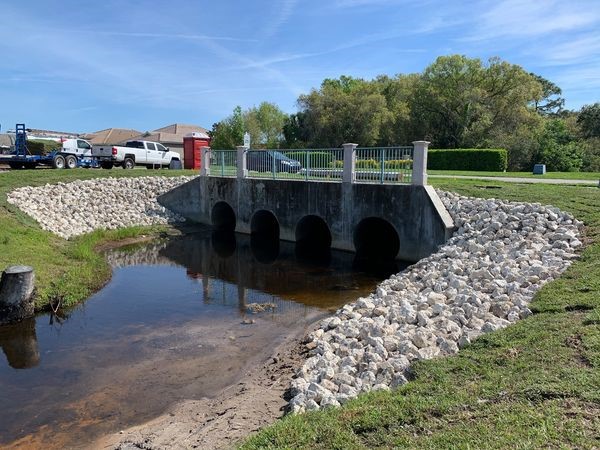Rock riprap is a commonly used erosion control measure that involves placing large, durable rocks or stones along shorelines, riverbanks, slopes, or other areas prone to erosion. It acts as a protective layer to reduce the erosive forces of water and prevent the loss of soil or sediment. Here’s how rock riprap is used for erosion control:
- Dissipating Energy: Riprap works by dissipating the energy of flowing water. When water encounters the irregular surface of the rocks, its velocity is reduced, and the kinetic energy is dissipated as the water flows around and through the gaps between the rocks. This helps prevent the erosion of soil or sediment behind the riprap.
- Reducing Velocity: The presence of rock riprap helps reduce the velocity of water. Slower water movement reduces the erosive forces acting on the soil or sediment, minimizing erosion and preventing further degradation of the area.
Project Spotlight: Using rock riprap to reduce flow velocity within a residential high-water velocity ditch.
- Resisting Scour: Rock riprap provides resistance against the scouring action of water currents. The interlocking arrangement of rocks creates a stable and cohesive barrier that withstands the erosive forces. It protects the underlying soil from being eroded and helps maintain the integrity of slopes, embankments, or shorelines.
Here’s an example of how rock riprap is installed to reduce scouring at a bridge revetment located within a homeowners association (HOA).
- Absorbing Wave Energy: In coastal areas or locations exposed to waves, rock riprap helps absorb and dissipate the energy of incoming waves. The rocks break the wave action, reducing the erosive impact on the shoreline and preventing the loss of sediment.
Here’s an example of how a community with a large lake which generated heavy wind action installed rock riprap in combination with land reclamation efforts to protect its waterfront homes.
- Enhancing Stability: By stabilizing the surface, rock riprap helps prevent slumping, sliding, or collapse of slopes or embankments. It provides structural stability, preventing soil or sediment from being washed away and maintaining the integrity of the protected area.
- Facilitating Drainage: Rock riprap allows water to flow through and around the rocks, preventing the buildup of hydrostatic pressure and ensuring proper drainage. This helps avoid the accumulation of water behind the riprap, which could potentially contribute to erosion.
It’s important to note that the design and installation of rock riprap requires careful consideration of factors such as water flow rates, slope stability, wave action, and the size and arrangement of rocks. Proper engineering practices and expertise are necessary to ensure effective erosion control and long-term stability.
Rock riprap is often used in combination with other erosion control techniques, such as retaining stabilization or geotextiles, to enhance the overall erosion resistance of an area. The specific design and application of rock riprap depend on the site conditions and the desired level of erosion control needed.
If you have any questions about the application of rock riprap for your embankment protection, we encourage you to reach out to Landshore. Our team of experts is ready to review your specific challenges and assist you in finding the best possible solutions. For more valuable insights and updates from our engineering team, be sure to follow us on our social media channels listed below. We look forward to connecting with you and helping you alleviate your erosion control problems for your property.

